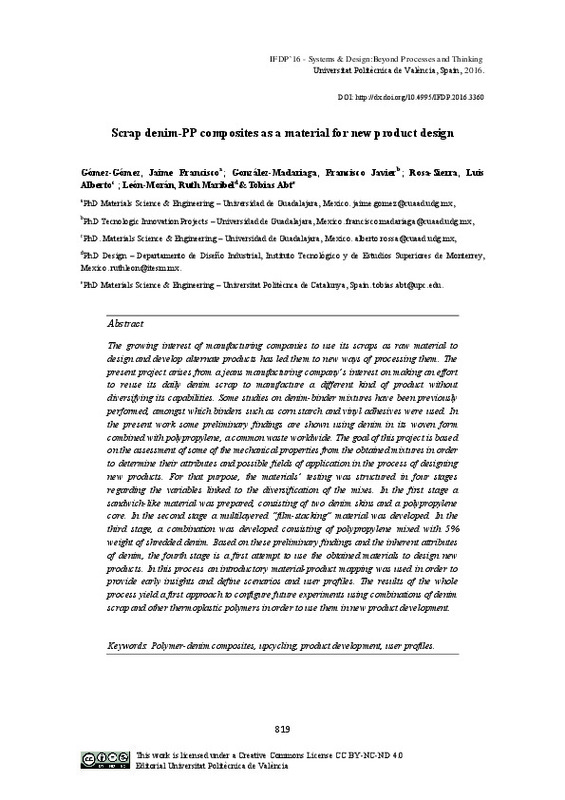JavaScript is disabled for your browser. Some features of this site may not work without it.
Buscar en RiuNet
Listar
Mi cuenta
Estadísticas
Ayuda RiuNet
Admin. UPV
Scrap denim-PP composites as a material for new product design
Mostrar el registro sencillo del ítem
Ficheros en el ítem
| dc.contributor.author | Gómez Gómez, Jaime
|
es_ES |
| dc.contributor.author | González Madariaga, Francisco
|
es_ES |
| dc.contributor.author | Rosa Sierra, Luis
|
es_ES |
| dc.contributor.author | León Morán, Ruth
|
es_ES |
| dc.contributor.author | Abt, Tobias
|
|
| dc.date.accessioned | 2017-10-27T10:36:46Z | |
| dc.date.available | 2017-10-27T10:36:46Z | |
| dc.date.issued | 2016-10-27 | |
| dc.identifier.isbn | 9788490484401 | |
| dc.identifier.uri | http://hdl.handle.net/10251/90145 | |
| dc.description.abstract | [EN] The growing interest of manufacturing companies to use its scraps as raw material to design and develop alternate products has led them to news ways of processing them. The present project arises from a jeans manufacturing company’s interest on making an effort to reuse its daily denim scrap to manufacture a different kind of product without diversifying its capabilities. Some studies on denim-binder mixtures have been previously performed, amongst which binders such as corn starch and vinyl adhesives were used. In the present work some preliminary findings are shown using denim in its woven form combined with polypropylene, a common waste worldwide. The goal of this project is based on the assessment of some of the mechanical properties from the obtained mixtures in order to determine their attributes and possible fields of application in the process of designing new products. For that purpose, the materials’ testing was structured in four stages regarding the variables linked to the diversification of the mixes. In the first stage a sandwich-like material was prepared, consisting of two denim skins and a polypropylene core. In the second stage a multilayered “film-stacking” material was developed. In the third stage, a combination was developed consisting of polypropylene mixed with 5% weight of shredded denim. Based on these preliminary findings and the inherent attributes of denim, the fourth stage is a first attempt to use the obtained materials to design new products. In this process an introductory material-product mapping was used in order to provide early insights and define scenarios and user profiles. The results of the whole process yield a first approach to configure future experiments using combinations of denim scrap and other thermoplastic polymers in order to use them in new product development.DOI: http://dx.doi.org/10.4995/IFDP.2016.3360 | es_ES |
| dc.description.uri | http://ocs.editorial.upv.es/index.php/IFDP/IFDP | es_ES |
| dc.language | Inglés | es_ES |
| dc.publisher | Editorial Universitat Politècnica de València | es_ES |
| dc.relation.ispartof | Systems&Design: Beyond Processes and Thinking | |
| dc.rights | Reconocimiento - No comercial - Sin obra derivada (by-nc-nd) | es_ES |
| dc.subject | Polymer-denim composites | |
| dc.subject | Upcycling | |
| dc.subject | Product development | |
| dc.subject | User profiles | |
| dc.title | Scrap denim-PP composites as a material for new product design | es_ES |
| dc.type | Capítulo de libro | es_ES |
| dc.type | Comunicación en congreso | es_ES |
| dc.identifier.doi | 10.4995/IFDP.2015.3360 | |
| dc.rights.accessRights | Abierto | es_ES |
| dc.description.bibliographicCitation | Gómez Gómez, J.; González Madariaga, F.; Rosa Sierra, L.; León Morán, R.; Abt, T. (2016). Scrap denim-PP composites as a material for new product design. En Systems&Design: Beyond Processes and Thinking. Editorial Universitat Politècnica de València. https://doi.org/10.4995/IFDP.2015.3360 | es_ES |
| dc.description.accrualMethod | OCS | es_ES |
| dc.relation.conferencename | Systems & Design: Beyond Processes and Thinking | es_ES |
| dc.relation.conferencedate | June 22-24,2016 | es_ES |
| dc.relation.conferenceplace | Valencia, Spain | es_ES |
| dc.relation.publisherversion | http://ocs.editorial.upv.es/index.php/IFDP/IFDP/paper/view/3360 | es_ES |
| dc.type.version | info:eu-repo/semantics/publishedVersion | es_ES |
| dc.relation.pasarela | OCS\3360 | es_ES |








